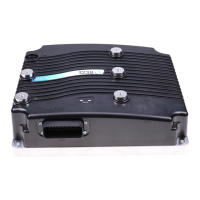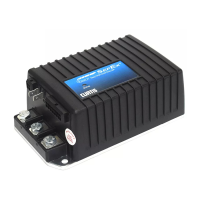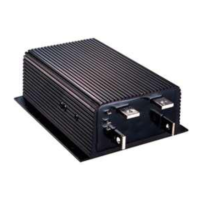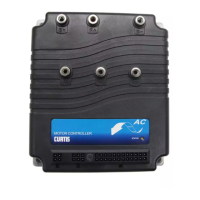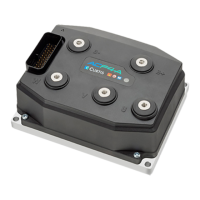2 — INSTALLATION AND WIRING
Curtis AC F4-A Motor Controller – August 2020 Return to TOC
pg. 16
Potentiometer Inputs with Dynamic Testing
In this manual, the term throttle is for the traction motors. If the vehicle uses a dual drive system,
the single throttle input controls both traction motors. Figure 6 illustrates the traction-drive throttle
as a traditional 3-wire potentiometer (pot) using pin 16 (Pot 1 Wiper), although Hall-eect voltage
throttles are more common today. e brake throttle in Figure 6 is via a 2-wire pot. Using CAN-
based throttles, as illustrated in Figure 7, frees the throttle (or brake) analog inputs for other usages.
For example, in a dual-drive system, a CAN-based throttle frees a potentiometer input for use as the
steer-angle input.
e three basic wired throttles use these analog inputs congurations:
0 = Voltage input (see Table 6 and Figure 28 {voltage throttle in commissioning chapter})
1 = 3-Wire Pot (see Table 7 and Figure 25 {3-wire throttle in commissioning chapter})
2 = 2-Wire Pot (see Table 7 and Figure 26 {2-wire throttle in commissioning chapter})
In Programmer, when selecting Analog 1 Type as a 3-wire pot, Analog 6 becomes unavailable. When
selecting Analog 18 as a 3-wire pot, Analog 19 becomes unavailable. e 3-wire potentiometer pin
names are:
Pin 16 = Pot 1 Wiper
Pin 15 = Pot 6 Supply
Pin 17 = Pot 18 Wiper
Pin 27 = Pot 19 Supply
Note: e 3-wire potentiometer throttle provides complete throttle-fault protection that meets
the applicable EEC regulations. For voltage throttles, the congured-pins protect against out-
of-range input values, but do not detect external wiring faults; it is therefore the responsibility
of the OEM to provide full throttle fault protection in vehicles using voltage, current, or CAN-
based throttles.
e potentiometer inputs contain internal circuits, which dynamically test the wiper and pot high
connections to enable detection of the following faults:
• Pot wiper connected to B+ at any time.
• Pot wiper connected to B– at any time (if this could produce movement).
• Pot high connected to B+ at any time.
• Pot high connected to B– at any time.
• Pot wiper shorted to ground at any time (if this could produce movement).
• Pot wiper shorted to pot high at any time.
• Pot high shorted to ground at any time.
• Other internal tests ensure the potentiometer inputs remains valid.
erefore, when conguring an input as a potentiometer, always use the percent value for the reading,
not the voltage. e voltage value will vary based upon the dynamic test (it is not for control usage).
Quick Links:
Fig 6 p.10
Fig 7 p.11
Fig7a p.12
Fig 25 p. 135
Fig 26 p. 136
Fig 28 p. 138
Programmer p. 88
